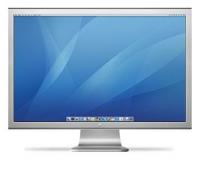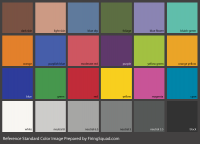How to buy an LCD
 Apple LCD (not reviewed)Budget LCD Roundup April 2005 (Firing Squad) is a perfect guide for people looking to buy an LCD. Let me rephrase that to anyone looking for a computer, because CRTs barely even exist anymore. In fact,
Apple LCD (not reviewed)Budget LCD Roundup April 2005 (Firing Squad) is a perfect guide for people looking to buy an LCD. Let me rephrase that to anyone looking for a computer, because CRTs barely even exist anymore. In fact,
“For those of you who still have a CRT monitor on your desk right now, know that it will likely be the last CRT you will ever own. … Your vintage high-end CRT is better than many CRTs being produced today.*”
*That’s me. I’ve got two vintage 19" Viewsonics, both 5 years old.
Pixel Speed
So, LCD it is, then. The faster, the better right? Wrong. It’s best to be careful on pixel refresh speeds, as manufacturers like to quote “best-case scenario[s]” instead of averages. Additionally, there are different types of screens out there (“S-IPS, TN-film, and PVA/MVA”), which differ in their abilities to transition from one color to another. Some have trouble with black to white, others with black to grey − that’s why average pixel speed is important. Other important things to remember are:
“IPS panels typically offer better viewing angles with more accurate color, however contrast is poorer. TN-Film technology (the 8, 12 and 16 ms) panels only display 18-bit color. PVA/MVA panels on the other hand are famed for deep black levels and superb contrast ratios that typically come [at] the expense of speed.”
For many people, viewing angle or deep contrast is much more important than pixel speed. For old CRT hands, it takes a little while to get used to the fact that refresh rate no longer matters. LCDs don’t flicker. Period. Forget about it as if it was a bad dream. LCDs on the other hand have a problem with “smearing”, this is the phenomenon where the screen is changing more quickly than the screen can refresh, resulting in a messy watercolor feel. It also makes you lose games. Here are the break-even levels for the different types of panels:
“…at 12 ms or faster, we found the smearing associated with TN-film panels to be non-intrusive. … 16 ms TN-film is a good starting point as a minimum spec and most gamers will be happy with this level of blurring. We found the 12 ms PVA panels to perform similarly to the 16 ms TN-film panels. … 25ms PVA panels were too slow for high-speed gaming … DVD movies will look fine. 25 ms IPS panels were on par with 16 ms TN-film panels.”
DVI
As for DVI? “ If there’s one absolute of buying an LCD monitor, it is to get a monitor with DVI support.”. VGA output does not have better color; DVI is perfect digital convesion of the intended color … how can an analog interpretation of a voltage level be better? VGA is not “as sharp as DVI” thanks to better analog-to-digital converters. Those are both myths. Don’t forget that your video card needs DVI output too; older cards won’t have it, but you can upgrade pretty cheaply. ‘Nuff said.
Contrast
““Contrast ratio” is measured by comparing the intensity of the brightest white and the darkest black” and is often an important part of LCD reviews, because it is a value that can be optimized without actually improving overall picture quality. In fact, “the most important element is neither contrast ratio nor brightness, but color accuracy”. Take a look at the two pictures below; the second one actually has a higher contrast ratio (difference between black and white) than the first … it just sucks at all of the colors in between.
You can provoke the same bad effects by messing with the contrast slider in any graphics program. At some point, the transitions are so stark that details are washed out.
So, if color is more important than constrast (obvious when you think about it), how do you measure it? The picture below “is a patch of 24 scientifically selected colored squares in a wide range of colors that represent natural objects such as human skin, foliage, and blue skies and have stood up to the test of time. Doing well with these 24 colors is predictive for doing well with all 16.7M colors.” The screenshot of the graphic on a given monitor against the reference graphic indicates whether it tends to blue, green or red. “[T]he absolute color isn’t what’s important”, so don’t worry if your monitor has a tinge as well − that tinge is applied equally to both graphics and you’ll still see the relative difference applied by the monitor in question.
One last thing to note is that a color profile can be applied by the operating system to correct inherent tinging. This applies to everything that appears on screen, including games, but not including video overlays as used in DVDs. If you’re going to watch a lot of films and absolute color is important, make sure to get a quality LCD out of the box. Also, make sure to calibrate your monitor, as manufacturers tend to ship at higher color temperatures that look brighter, but are false. See Color Temperature for more information.
How do top-end CRTs fare? A “4-year-old Iiyama i90A CRT … was an order of magnitude superior to any other LCD” in pixel refresh and lack of smearing. “[A] black level of 0.01 cd/m2 and a peak brightness of 94.15 cd/m2 for a staggering contrast ratio of almost 9415:1” put the CRT in a league of its own contrast-wise and “the average color accuracy was notably more accurate than even the best LCD. Once calibrated, the Iiyama CRT was nearly flawless.”
What does that mean? Should you start hording vintage, high-quality CRTs? No. Most people will never need nor notice the additional quality offered by the top-of-the-line CRT. Heck, most people don’t even calibrate their color in the first place, regardless of monitor. The better LCDs found in this review (all around $300) are excellent for gaming, watching DVDs and anything else you want to do. If you’ve already got a good CRT and have the room for it, you can smile smugly to yourself. Just remember, LCDs are the future and will continue to get better.


